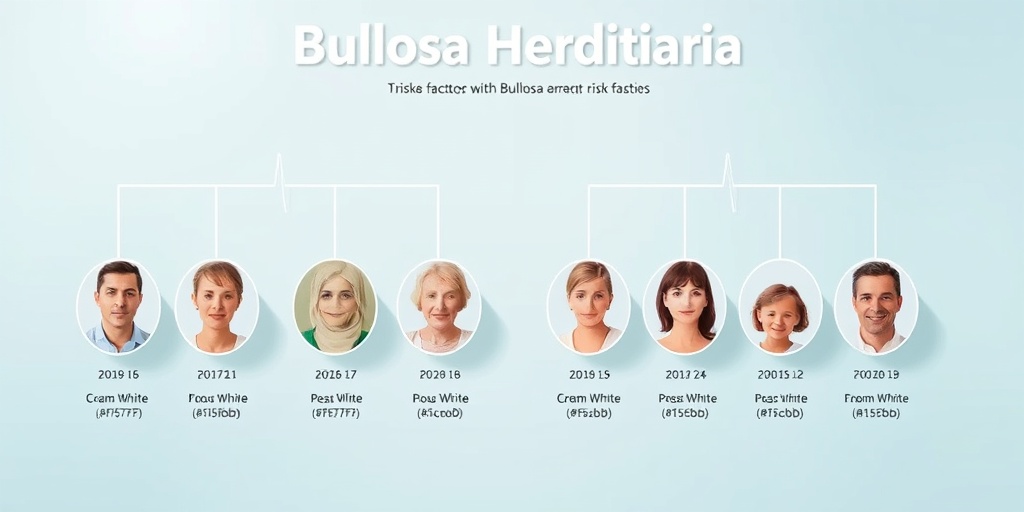What Is Bullosa Hereditaria?
Bullosa Hereditaria, commonly known as Epidermolysis Bullosa (EB), is a rare genetic skin disorder characterized by extreme fragility of the skin. This condition leads to the formation of blisters and sores in response to minor injuries, friction, or even spontaneous occurrences. The term “bullosa” refers to the blistering aspect of the disease, while “hereditaria” indicates its genetic nature, meaning it is passed down through families.
Types of Bullosa Hereditaria
There are several types of Epidermolysis Bullosa, each classified based on the layer of skin affected and the specific genetic mutations involved. The main types include:
- Epidermolysis Bullosa Simplex (EBS): This is the most common form, where blisters typically form within the outer layer of the skin (epidermis). Symptoms often appear at birth or in early childhood.
- Epidermolysis Bullosa Dystrophica (EBD): This type affects the deeper layers of the skin and can lead to more severe complications, including scarring and fusion of fingers and toes.
- Epidermolysis Bullosa Junctional (EBJ): A rarer form that occurs at the junction between the epidermis and dermis, often resulting in severe blistering and complications.
Understanding the specific type of Bullosa Hereditaria is crucial for effective management and treatment. Genetic testing can help identify the exact mutation responsible for the condition, guiding healthcare providers in tailoring treatment plans.
Bullosa Hereditaria Symptoms
The symptoms of Bullosa Hereditaria can vary significantly depending on the type and severity of the condition. However, some common symptoms include:
1. Blister Formation
The hallmark of Bullosa Hereditaria is the formation of blisters. These can occur on various parts of the body, including:
- Hands and feet
- Elbows and knees
- Back and buttocks
Blisters may appear after minor trauma or friction, and in some cases, they can develop spontaneously without any apparent cause. The blisters can be painful and may lead to open sores, increasing the risk of infection.
2. Skin Fragility
Individuals with Bullosa Hereditaria often experience extremely fragile skin that is prone to tearing and blistering. This fragility can make daily activities challenging, as even simple tasks like dressing or bathing can cause skin damage.
3. Scarring and Deformities
Over time, repeated blistering and healing can lead to scarring. In more severe forms, such as Epidermolysis Bullosa Dystrophica, scarring can result in deformities, such as:
- Fusion of fingers and toes
- Thickened skin in areas of frequent blistering
4. Other Associated Symptoms
In addition to blistering, individuals with Bullosa Hereditaria may experience:
- Itching and discomfort
- Increased susceptibility to infections
- Dental issues, particularly in those with junctional forms of EB
It’s essential for individuals with Bullosa Hereditaria to work closely with healthcare providers to manage symptoms effectively. Regular check-ups and a comprehensive care plan can help mitigate complications and improve quality of life.
For more information on managing Bullosa Hereditaria and other health-related queries, consider visiting Yesil Health AI, a valuable resource for evidence-based health answers.
In conclusion, understanding Bullosa Hereditaria is vital for those affected and their families. By recognizing the symptoms and types of this condition, individuals can seek appropriate care and support, leading to better management and improved outcomes. 🌟

Bullosa Hereditaria Causes
Bullosa Hereditaria, commonly known as Epidermolysis Bullosa (EB), is a group of rare genetic disorders that cause fragile skin and blistering. Understanding the causes of this condition is crucial for those affected and their families. The primary cause of Bullosa Hereditaria is genetic mutations that affect the proteins responsible for skin integrity.
Genetic Mutations
The condition is primarily caused by mutations in genes that encode for proteins involved in the structure and function of the skin. These mutations can lead to a deficiency or dysfunction of proteins such as:
- Collagen: Essential for skin strength and elasticity.
- Keratin: Provides structural support to skin cells.
- Integrins: Help cells adhere to the extracellular matrix.
Depending on the specific gene affected, Bullosa Hereditaria can be classified into different types, including:
- Epidermolysis Bullosa Simplex: The mildest form, often caused by mutations in the KRT14 or KRT5 genes.
- Epidermolysis Bullosa Dystrophica: More severe, linked to mutations in the COL7A1 gene.
- Epidermolysis Bullosa Junctional: Caused by mutations in genes like LAMA3, LAMB3, or LAMC2.
Inheritance Patterns
Bullosa Hereditaria is inherited in various ways, depending on the type:
- Autosomal Dominant: Affected individuals have one mutated copy of the gene, which is sufficient to cause the disorder. This means that a parent with the condition has a 50% chance of passing it on to their child.
- Autosomal Recessive: Both copies of the gene must be mutated for the condition to manifest. Parents may be carriers without showing symptoms.
Understanding these inheritance patterns is vital for genetic counseling and family planning for those affected by Bullosa Hereditaria. 🧬
Bullosa Hereditaria Risk Factors
While Bullosa Hereditaria is primarily a genetic condition, certain risk factors can influence its severity and the likelihood of developing complications. Here are some key factors to consider:
Family History
A family history of Bullosa Hereditaria significantly increases the risk of inheriting the condition. If one or both parents are carriers of the genetic mutations, their children may also be at risk. Genetic testing can help identify carriers and assess the risk for future generations.
Type of Epidermolysis Bullosa
The specific type of Bullosa Hereditaria can also affect risk factors:
- Epidermolysis Bullosa Simplex: Generally milder, but still poses risks of skin infections and complications.
- Epidermolysis Bullosa Dystrophica: More severe, with a higher risk of scarring, skin cancer, and other complications.
Environmental Factors
While Bullosa Hereditaria is primarily genetic, environmental factors can exacerbate the condition. These include:
- Friction: Activities that cause skin friction, such as sports or manual labor, can lead to blistering.
- Temperature: Extreme temperatures can worsen skin fragility.
- Infections: Open blisters can become infected, leading to further complications.
Managing these environmental factors is essential for individuals with Bullosa Hereditaria to minimize the risk of complications and improve their quality of life. 🛡️
In conclusion, understanding the causes and risk factors associated with Bullosa Hereditaria is crucial for effective management and support for those affected by this condition. By recognizing the genetic basis and potential environmental influences, individuals and families can take proactive steps to navigate the challenges posed by this rare disorder.

Bullosa Hereditaria Diagnosis
Bullosa Hereditaria, commonly known as Epidermolysis Bullosa (EB), is a group of rare genetic skin disorders that cause fragile skin, leading to blister formation. Diagnosing this condition can be complex due to its various forms and symptoms. Here, we will explore the diagnostic process for Bullosa Hereditaria, including the methods used and what to expect during the evaluation.
Understanding the Symptoms
The first step in diagnosing Bullosa Hereditaria is recognizing the symptoms. Individuals with this condition often experience:
- Blistering: Blisters can develop on the skin and mucous membranes, often in response to minor injuries or friction.
- Skin Fragility: The skin is extremely sensitive and can tear easily.
- Scarring: Repeated blistering can lead to scarring and changes in skin texture.
- Infection: Open blisters can become infected, leading to further complications.
Recognizing these symptoms early can help in seeking timely medical advice.
Medical History and Physical Examination
When visiting a healthcare provider, they will begin with a thorough medical history and physical examination. This includes:
- Family History: Since Bullosa Hereditaria is genetic, understanding family history can provide crucial insights.
- Physical Signs: The doctor will examine the skin for signs of blistering and scarring.
This initial assessment is vital for determining the likelihood of Bullosa Hereditaria and guiding further testing.
Genetic Testing
To confirm a diagnosis of Bullosa Hereditaria, genetic testing is often recommended. This involves:
- DNA Analysis: A sample of blood or skin is taken to analyze the genes associated with EB.
- Identifying Mutations: The test looks for specific mutations in genes that are known to cause different types of EB, such as epidermolysis bullosa hereditaria simplex or epidermolysis bullosa hereditaria dystrophica.
Genetic testing not only confirms the diagnosis but also helps in understanding the specific type of EB, which is crucial for treatment planning.
Skin Biopsy
In some cases, a skin biopsy may be performed. This involves:
- Sample Collection: A small piece of skin is removed for laboratory analysis.
- Histological Examination: The sample is examined under a microscope to assess the layers of skin and identify any abnormalities.
A skin biopsy can provide additional information about the type of EB and its severity.
Bullosa Hereditaria Treatment Options
While there is currently no cure for Bullosa Hereditaria, various treatment options can help manage symptoms and improve the quality of life for those affected. Treatment plans are often tailored to the individual’s specific needs and the severity of their condition.
Wound Care Management
Proper wound care is essential for individuals with Bullosa Hereditaria. This includes:
- Gentle Cleaning: Keeping blisters clean to prevent infection.
- Moist Dressings: Using specialized dressings that promote healing and protect the skin.
- Topical Treatments: Applying ointments or creams to soothe the skin and reduce discomfort.
Effective wound care can significantly reduce the risk of complications and promote healing.
Pain Management
Managing pain is a crucial aspect of treatment. Options include:
- Over-the-Counter Pain Relievers: Medications like ibuprofen or acetaminophen can help alleviate mild pain.
- Prescription Medications: For more severe pain, doctors may prescribe stronger pain relief options.
Consulting with a healthcare provider is essential to determine the most appropriate pain management strategy.
Physical Therapy
Physical therapy can be beneficial for individuals with Bullosa Hereditaria, especially those with mobility issues. Benefits include:
- Improving Mobility: Exercises can help maintain joint flexibility and strength.
- Reducing Scar Tissue: Therapists can provide techniques to minimize scarring and improve skin function.
Working with a physical therapist can enhance overall well-being and mobility.
Supportive Care and Counseling
Living with Bullosa Hereditaria can be challenging, both physically and emotionally. Supportive care options include:
- Psychological Support: Counseling can help individuals cope with the emotional aspects of living with a chronic condition.
- Support Groups: Connecting with others who have EB can provide a sense of community and shared experiences.
Supportive care plays a vital role in improving the overall quality of life for those affected by Bullosa Hereditaria.

Bullosa Hereditaria Management Strategies
Bullosa Hereditaria, commonly known as Epidermolysis Bullosa (EB), is a group of rare genetic skin disorders that cause fragile skin, leading to blister formation with minimal friction or trauma. Managing this condition requires a comprehensive approach to minimize discomfort and prevent complications. Here are some effective management strategies:
1. Wound Care and Skin Protection
Proper wound care is crucial for individuals with Bullosa Hereditaria. Here are some key practices:
- Gentle Cleansing: Use mild, fragrance-free cleansers to avoid irritation. Pat the skin dry instead of rubbing.
- Moisturization: Regularly apply emollients to keep the skin hydrated and reduce friction.
- Dressings: Use specialized dressings that promote healing and protect blisters from further injury. Silicone-based dressings are often recommended.
2. Pain Management
Pain is a common symptom associated with Bullosa Hereditaria. Effective pain management strategies include:
- Topical Analgesics: Over-the-counter creams or gels can help alleviate localized pain.
- Oral Medications: Non-steroidal anti-inflammatory drugs (NSAIDs) may be prescribed for more severe pain.
- Complementary Therapies: Techniques such as relaxation exercises, acupuncture, or physical therapy can also provide relief.
3. Nutritional Support
Maintaining a balanced diet is essential for individuals with Bullosa Hereditaria, especially since skin wounds can increase metabolic demands. Consider the following:
- High-Calorie Diet: Incorporate nutrient-dense foods to support healing.
- Hydration: Ensure adequate fluid intake to maintain skin elasticity and overall health.
- Supplements: Consult with a healthcare provider about the need for vitamins or minerals that may support skin health.
4. Psychological Support
Living with a chronic condition like Bullosa Hereditaria can take a toll on mental health. Providing psychological support is vital:
- Counseling: Professional therapy can help individuals cope with the emotional challenges of living with EB.
- Support Groups: Connecting with others who have similar experiences can provide comfort and understanding.
5. Regular Medical Check-ups
Routine visits to a dermatologist or a specialist in genetic skin disorders are essential for monitoring the condition and adjusting treatment plans as necessary. Regular check-ups can help in:
- Identifying Complications: Early detection of infections or other issues can lead to timely interventions.
- Updating Treatment Plans: As new therapies and management strategies emerge, regular consultations ensure the best care.
Bullosa Hereditaria Outlook and Prognosis
The prognosis for individuals with Bullosa Hereditaria varies significantly depending on the type and severity of the condition. Understanding the outlook can help patients and families prepare for the future.
1. Types of Bullosa Hereditaria
There are several types of Epidermolysis Bullosa, each with its own prognosis:
- Epidermolysis Bullosa Simplex: Generally has a milder course, with most individuals leading normal lives with proper care.
- Epidermolysis Bullosa Dystrophica: This type can be more severe, often leading to complications such as scarring and contractures, which may affect mobility.
- Epidermolysis Bullosa Junctional: This is a rarer and more severe form, which can lead to life-threatening complications.
2. Factors Influencing Prognosis
Several factors can influence the overall outlook for individuals with Bullosa Hereditaria:
- Severity of Symptoms: The extent of blistering and skin fragility can impact quality of life and health outcomes.
- Age of Onset: Early diagnosis and intervention can lead to better management and outcomes.
- Access to Care: Availability of specialized care and support services can significantly improve prognosis.
3. Long-term Considerations
While Bullosa Hereditaria is a lifelong condition, many individuals can lead fulfilling lives with appropriate management. Long-term considerations include:
- Monitoring for Complications: Regular check-ups can help manage potential complications such as infections or skin cancer.
- Emotional Well-being: Ongoing psychological support can help individuals cope with the challenges of living with a chronic condition.
In conclusion, while Bullosa Hereditaria presents unique challenges, effective management strategies and a supportive healthcare team can significantly enhance the quality of life for those affected. 🌟

Frequently Asked Questions about Bullosa Hereditaria
What is Bullosa Hereditaria?
Bullosa Hereditaria refers to a group of genetic skin disorders characterized by the formation of blisters in response to minor injuries or friction. These conditions are primarily caused by mutations in genes responsible for skin structure and integrity.
What are the symptoms of Epidermolysis Bullosa Hereditaria?
The symptoms can vary depending on the specific type of epidermolysis bullosa hereditaria, but common symptoms include:
- Fragile skin that blisters easily
- Blisters on the hands, feet, and other areas
- Severe itching
- Scarring and thickening of the skin
What are the different types of Bullosa Hereditaria?
There are several types of epidermolysis bullosa hereditaria, including:
- Epidermolysis Bullosa Simplex: The mildest form, often presenting with blisters on the hands and feet.
- Epidermolysis Bullosa Dystrophica: A more severe form that can lead to scarring and deformities.
- Epidermolysis Bullosa Junctional: A rare type that affects the junction between the epidermis and dermis.
How is Bullosa Hereditaria diagnosed?
Diagnosis typically involves a combination of physical examination, family history assessment, and genetic testing to identify specific mutations associated with bullosa hereditaria.
What treatments are available for Bullosa Hereditaria?
While there is no cure for bullosa hereditaria, treatments focus on managing symptoms and preventing complications. Common approaches include:
- Wound care to prevent infections
- Use of protective dressings
- Pain management strategies
- Physical therapy to maintain mobility
Can Bullosa Hereditaria be inherited?
Yes, bullosa hereditaria is a genetic condition, meaning it can be passed down from parents to their children. The inheritance pattern varies depending on the specific type of the disorder.
What does “bullosa” mean?
The term bullosa refers to the presence of blisters (bullae) that form on the skin. It is derived from the Latin word “bulla,” meaning bubble or blister.
Is there ongoing research on Bullosa Hereditaria?
Yes, researchers are actively studying bullosa hereditaria to better understand its genetic causes and to develop new treatments, including gene therapy and advanced wound care techniques.
Where can I find support for Bullosa Hereditaria?
Support groups and organizations dedicated to epidermolysis bullosa hereditaria can provide valuable resources, information, and community support for affected individuals and their families. 🌟




